Getting your Trinity Audio player ready...
Since the dawn of humanity, people have been gazing at the stars and tracking their movement. Possible evidence of this can be found in multiple cave drawings and engravings dated to tens of thousands of years ago, which researchers hypothesize describe different constellations.
Star maps, or star catalogs clearly detailing the stellar coordinates in the sky, dating back to about 3,500 years ago, have been discovered in Egypt and Babylon (modern-day Iraq). Descriptions of similar charts also exist from 2,500 years ago in ancient China.
The earliest known attempt to extensively and systematically map the entire visible sky is attributed to renowned Greek astronomer Hipparchus, who lived in the 2nd century B.C. For many generations, Hipparchus’ star catalog was considered lost and its existence was only known through mentions in later writings by other scholars. It was only in 2022 that a section of the original Hipparchus’ star catalog was found, hidden within writings discovered in Saint Catherine's Monastery in South Sinai.
Hipparchus is regarded as one of the greatest astronomers of ancient times, if not the greatest. His contributions extend beyond astronomy; he was also a mathematician and geographer. As a mathematician, he developed the branch of trigonometry, which helped him analyze his observations of celestial bodies.
Around 127 B.C., Hipparchus discovered the precession of the Earth's rotation axis when he compared his measurements of several bright stars with the documented measurements of astronomers from the 3rd century B.C. The direction of the Earth's rotation axis is not fixed; it changes slightly over time due to the gravitational effects of the Sun and the Moon. This axis completes a full rotation approximately every 25,788 years, akin to a spinning top whose handle rotates in a small circle rather than pointing straight up.
As a result of this precession, the apparent positions of stars and constellations in the sky have shifted over the centuries. For instance, the constellations associated with astrological signs now appear in the sky during different months compared to their traditional associations.
The identity of the North Star also changes for the same reason: Polaris is currently the star found closest to the celestial north pole, but 3,000 years ago a star simply known as ‘star’ in the Ursa Minor constellation held that position, and in about a thousand years the star Errai (Gamma Cephei) will take its place.
5 View gallery
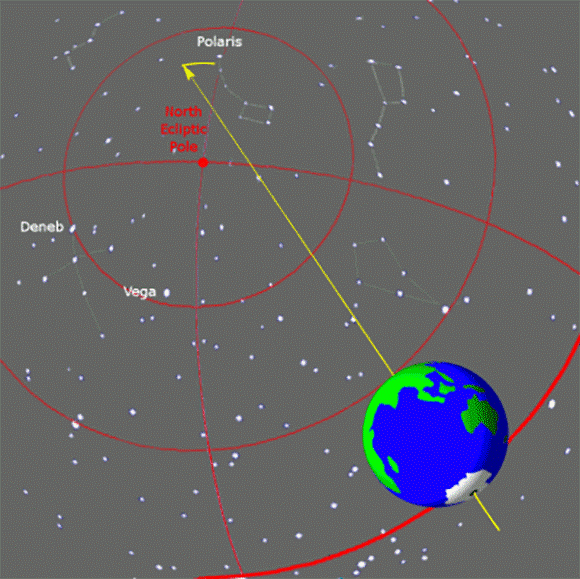

Precession of the Earth’s rotation axis shifts the visible location of constellations and alters the identity of the North star every few thousand years
(Illustration: Tfr000, Wikipedia)
Later in his career, Hipparchus composed the first extensive star catalog in the Western world. Previous star catalogs, such as the Babylonian star catalog, mainly focused on mapping stars along the ecliptic plane, which is the imaginary plane of the Earth’s orbit around the sun, defining the path of the Sun relative to distant stars.
In contrast, Hipparchus defined the coordinates across the entire celestial sphere using a coordinate network he himself devised. Using specialized measuring tools, some of which he designed or refined, Hipparchus systematically measured the positions of approximately 850 stars. Hipparchus is also credited with inventing the astrolabe, a device used for measuring stars positions for navigation, which was in use from the 2nd century A.D. until the 18th century.
Recently an 11th-century astrolabe was discovered in Italy, featuring inscriptions in Arabic and Hebrew. Additionally, it’s possible that Hipparchus utilized other measurement tools invented in the 3rd century B.C., including the armillary sphere—a model of the celestial sphere—and the dioptra, a type of tubular observation tool equipped with an angle-measuring device known as goniometer.
5 View gallery
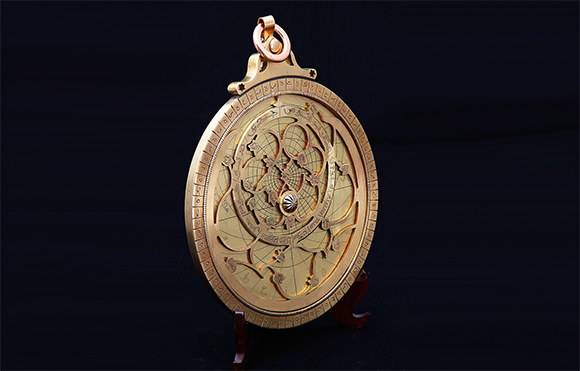

The invention of the astrolabe is attributed to Hipparchus during the 2nd century BC. A modern astrolabe produced in Iran in 2013
(Photo: Masoud Safarniya, Wikipedia)
Atlas’s map
In two lost essays, 4th century B.C. Greek astronomer Eudoxus of Cnidus in Asia Minor described the locations of various stars and constellations. Records of his work were preserved in the poem ‘Phaenomena’, composed by 3rd-century B.C. Greek poet Aratus. In his commentary on Aratus’s poem, Hipparchus included data on stellar coordinates and the times of appearance of different constellations.
Until recently, this commentary was the only surviving work of Hipparchus. Hipparchus’ star catalog is also mentioned in the writings of Pliny the Elder, a 1st-century A.D. Roman scholar. Additionally, stellar coordinates that could be attributed to Hipparchus are mentioned in the Latin translation of Aratus’s manuscript.
A 2nd century A.D Roman copy of a statue of Atlas, the titan from Greek mythology who holds up the celestial heavens on his shoulders, features the earliest visual depiction of the constellations known in ancient Greece. In 2005, physicist Bradley Schaefer used calculations of the Earth’s precession to date the depiction of the sky on the sphere held by Atlas to around 125 B.C. This dating suggests that Hipparchus’ star catalog may have served as the basis for the sky’s depiction in the statue.
5 View gallery
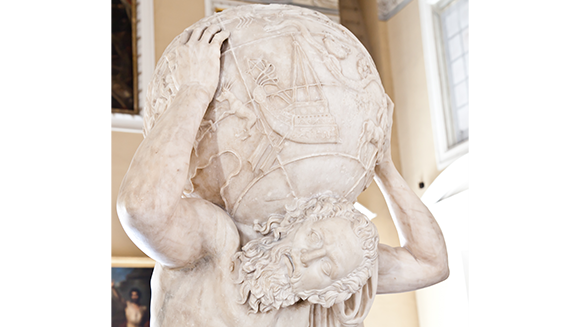

The celestial depiction on the globe held by Atlas enabled scholars to date the statue. A replica of the statue of Atlas holding up the celestial heavens on his shoulders
(Photo: Paolo Gallo, Shutterstock)
New reading into old scripture
The Codex Climaci Rescriptus is a collection of Aramaic and Greek manuscripts, which includes sections from the Old Testament, New Testament, and Jewish apocrypha, discovered in Saint Catherine's Monastery in South Sinai. Most of the codex’s pages are currently on display at the Museum of the Bible in Washington, D.C. The pages are palimpsests—parchments that have been reused after the original text was erased, either for economic reasons or due to a shortage of parchment.
In 2012, Jaime Klair, an undergraduate student from Cambridge University, examined some pages from the codex and noticed that the erased text beneath the later Greek writings dealt with astronomical matters. In 2021, biblical scholar Peter Williams identified these texts as astronomical measurements.
It was later revealed that some of the codex’s pages had previously been used in an older manuscript from the 5th or 6th century, which included Aratus’s poem. Unlike the Latin translation of the poem, which preserved Hipparchus’ measurements for only three constellations—Ursa Major, Ursa Minor, and Draco—the copy found in the Codex Climaci Rescriptus apparently originally included all the constellations listed in the Hipparchus star catalog.
But how is it possible to read the ancient text erased from the palimpsest? Since the erasure is incomplete, some of the ancient text is still visible to the naked eye. In the 19th century, different chemical solutions were used to reveal the ancient text, but these methods risked damaging the parchment. Today, optical techniques are employed: imaging the parchment under different wavelengths allows researchers to identify and distinguish the underlying text from the newer writing. This method is known as multispectral imaging.
5 View gallery
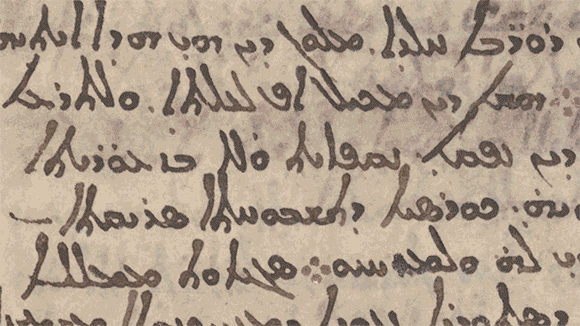

The hidden text. A section of Hipparchus’ star catalog found within the pages of the Codex Climaci Rescriptus. The image displays both the later text and undertext uncovered by multispectral imaging | Source: Museum of the Bible.
(Photo: Early Manuscripts Electronic Library/Lazarus Project, University of Rochester; multispectral processing by Keith T. Knox; tracings by Emanuel Zingg)
In a 2022 article in the Journal for the History of Astronomy, researchers Victor Gysembergh, Peter Williams and Emanuel Zingg presented the first findings from Hipparchus’ star catalog, as it appears in the undertext in the Codex Climaci Rescriptus. The short section that was revealed so far included location and size descriptions of the Corona Borealis constellation.
The stellar coordinates were accurate to within one degree of their actual location during the times of Hipparchus. Additionally, the coordinate system and the terms used in the revealed section were unique to Hipparchus and matched those used in the commentary on Aratus’s poem, which, as stated, is the only manuscript of his that has survived to this day. These findings reinforced the hypothesis that the revealed section originates from Hipparchus’ writings.
The researchers compared the measurements that appeared in the revealed section to measurements of the same stars that appear in the commentary on Aratus’s poem, finding a very high correlation. The high degree of correlation between the documented coordinates might indicate a joint origin for the three texts and also confirms the accepted convention that the commentary for the poem was written after the catalog was completed.
5 View gallery
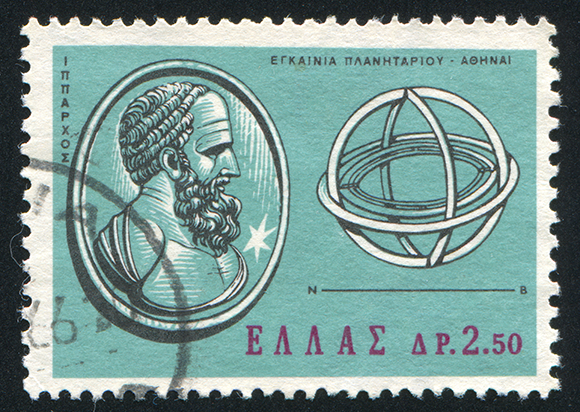

Some of his observations were remarkably accurate. Hipparchus’ image commemorated on a Greek postal stamp from the 1960’s
(Photo: rook76, Wikipedia )
Sometimes catalogs survive
The only extensive ancient star catalog that has survived to this day is that of the 2nd-century B.C. Hellenistic astronomer Claudius Ptolemy of Alexandria. In his monumental work ‘Almagest’, Ptolemy presents his philosophy regarding the movement of celestial bodies, alongside an updated sky catalog, based on that of Hipparchus.
Researchers comparing the coordinates in Ptolemy’s work with those in Hipparchus’ writing suggest that in contrast to the paradigm, Ptolemy’s catalog was based on independent measurements rather than merely on calculated additions of precession corrections to Hipparchus’ measurements. Additionally, it appears that Hipparchus’ measurements were more accurate than those of Ptolemy, who lived centuries later.
Ancient Babylonian astronomers meticulously tracked the movement of stars for centuries before Hipparchus and could even predict events such as solar eclipses. However, since their observations were motivated by religious purposes, they did not aim to develop a three-dimensional model to explain the movement of stars across the skies.
Hipparchus is considered the founder of modern astronomy, thanks to the mathematical models he developed. The discovery of a section from the original Hipparchus sky catalog, though limited in extent, sheds light on the quality of Hipparchus’ work, which was a cornerstone in the history of modern astronomy. Additional sections from the catalog may remain undiscovered, possibly within the pages of the Codex Climaci Rescriptus that have not yet been analyzed, or in other manuscripts from Saint Catherine's Monastery.

